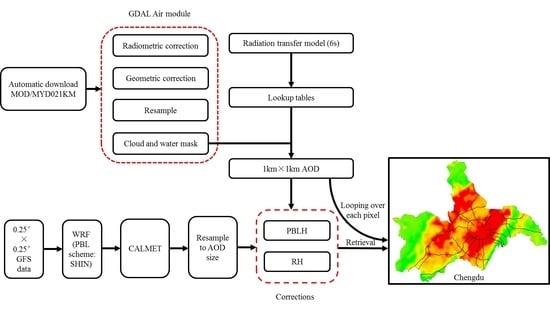Spatiotemporal Distribution of Satellite-Retrieved Ground-Level PM2.5 and Near Real-Time Daily Retrieval Algorithm Development in Sichuan Basin, China
Abstract
:1. Introduction
2. Methodology
2.1. Study Area Description
2.2. Data Sources
2.3. Data Analysis and Retrieval Algorithm Development
- (1)
- A script was used to automatically download the near real-time product from NASA. The original downloaded high-resolution MODIS product was first preprocessed via the Geospatial Data Abstraction Library (GDAL) Air module (including the radiometric and geometric corrections, resampling, and masking), then produced a high-resolution AOD product with the application of Lookup tables from the 6S radiation transmission model. At the same time, this AOD are verified by the Lidar AOD
- (2)
- Before conducting the retrieval of PM2.5, the regional WRF model with downscaling to 1 km resolution should be simulated with the Global Forecast System (GFS) initial forecast fields and the SHIN PBL scheme (the WRF model was set to automatically run at 6:00 a.m. of every day). The wrfout file was further used in the CALMET model, and the final output results of the gridded PBLH and RH should be resampled to the grids of the inversed high-resolution AOD product.
- (3)
- The PBLH from WRF_SHIN/CALMET (version information) was extracted and fitted with the vertical correction function on each pixel of the inversed AOD. The seasonal humidity correction function was also selected at the same time according to the specific date. Finally, the regional gridded PM2.5 concentrations were retrieved with vertical and humidity corrections after looping calculations over each pixel of the high-resolution AOD product.
3. Results and Discussion
3.1. Spatial and Temporal Distribution of Retrieved AOD
3.2. Vertical Correction of Extinction Coefficient
3.3. Humidity Correction of Extinction Coefficient
4. Conclusions
Supplementary Materials
Acknowledgments
Author Contributions
Conflicts of Interest
References
- Pöschl, U. Atmospheric aerosols: Composition, transformation, climate and health effects. Angew. Chem. Int. Ed. 2005, 44, 7520–7540. [Google Scholar] [CrossRef] [PubMed]
- Mahowald, N.; Ward, D.S.; Kloster, S.; Flanner, M.G.; Heald, C.L.; Heavens, N.G.; Hess, P.G.; Lamarque, J.F.; Chuang, P.Y. Aerosol impacts on climate and biogeochemistry. Annu. Rev. Environ. Resour. 2011, 36, 45–74. [Google Scholar] [CrossRef]
- Lohmann, U.; Feichter, J. Global indirect aerosol effects: A review. Atmos. Chem. Phys. 2005, 5, 715–737. [Google Scholar] [CrossRef]
- Rd, P.C.; Burnett, R.T.; Thun, M.J.; Calle, E.E.; Krewski, D.; Ito, K.; Thurston, G.D. Lung cancer, cardiopulmonary mortality, and long-term exposure to fine particulate air pollution. JAMA 2002, 287, 1132–1141. [Google Scholar]
- Chen, L.C.; Lippmann, M. Effects of metals within ambient air particulate matter (PM) on human health. Inhal. Toxicol. 2009, 21, 1–31. [Google Scholar] [CrossRef] [PubMed]
- Huang, R.J.; Zhang, Y.; Bozzetti, C.; Ho, K.F.; Cao, J.J.; Han, Y.; Daellenbach, K.R.; Slowik, J.G.; Platt, S.M.; Canonaco, F.; et al. High secondary aerosol contribution to particulate pollution during haze events in China. Nature 2014, 514, 218–222. [Google Scholar] [CrossRef] [PubMed] [Green Version]
- Zhang, X.Y.; Wang, Y.Q.; Niu, T.; Zhang, X.C.; Gong, S.L.; Zhang, Y.M.; Sun, J.Y.; Brandt, J. Atmospheric aerosol compositions in China: Spatial/temporal variability, chemical signature, regional haze distribution and comparisons with global aerosols. Atmos. Chem. Phys. 2012, 12, 779–799. [Google Scholar] [CrossRef] [Green Version]
- Hoff, R.M.; Christopher, S.A. Remote sensing of particulate pollution from space: Have we reached the promised land? J. Air Waste Manag. Assoc. 2009, 59, 645–675. [Google Scholar] [CrossRef] [PubMed]
- Gupta, P.; Christopher, S.A.; Wang, J.; Gehrig, R.; Lee, Y.; Kumar, N. Satellite remote sensing of particulate matter and air quality assessment over global cities. Atmos. Environ. 2006, 40, 5880–5892. [Google Scholar] [CrossRef]
- Donkelaar, A.V.; Martin, R.V.; Brauer, M.; Boys, L.B. Global Fine Particulate Matter Concentrations from Satellite for Long-Term Exposure Assessment. Assessment 2015, 3, 4. [Google Scholar]
- Nicolantonio, W.D.; Cacciari, A.; Bolzacchini, E.; Ferrero, L.; Volta, M.; Pisoni, E. MODIS aerosol optical properties over North Italy for estimating surface-level PM2.5. In Proceedings of the Envisat Symposium, Montreux, Switzerland, 23–27 July 2007. [Google Scholar]
- Van Donkelaar, A.; Martin, R.V.; Brauer, M.; Kahn, R.; Levy, R.; Verduzco, C.; Villeneuve, P.J. Global estimates of ambient fine particulate matter concentrations from satellite-based aerosol optical depth: Development and application. Environ. Health Perspect. 2010, 118, 847–855. [Google Scholar] [CrossRef] [PubMed]
- Van Donkelaar, A.; Martin, R.V.; Park, R.J. Estimating ground-level PM2.5 using aerosol optical depth determined from satellite remote sensing. J. Geophys. Res. Atmos. 2006, 111, 5049–5066. [Google Scholar] [CrossRef]
- You, W.; Zang, Z.; Pan, X.; Zhang, L.; Chen, D. Estimating PM2.5 in Xi’an, China using aerosol optical depth: A comparison between the MODIS and MISR retrieval models. Sci. Total Environ. 2015, 505, 1156–1165. [Google Scholar] [CrossRef] [PubMed]
- Chudnovsky, A.A.; Kostinski, A.; Lyapustin, A.; Koutrakisa, P. Spatial scales of pollution from variable resolution satellite imaging. Environ. Pollut. 2013, 172, 131–138. [Google Scholar] [CrossRef] [PubMed]
- Lyapustin, A.I.; Wang, Y.; Laszlo, I.; Hilker, T.; Hall, F.G.; Sellers, P.J.; Tucker, C.J.; Korkin, S.V. Multi-angle implementation of atmospheric correction for MODIS (MAIAC): 3. Atmospheric correction. Remote Sens. Environ. 2012, 127, 385–393. [Google Scholar] [CrossRef]
- Van Donkelaar, A.; Martin, R.V.; Brauer, M.; Hsu, N.C.; Kahn, R.A.; Levy, R.C.; Lyapustin, A.; Winker, D.M. Global estimates of fine particulate matter using a combined geophysical-statistical method with information from satellites, models, and monitors. Environ. Sci. Technol. 2016, 50, 3762–3772. [Google Scholar] [CrossRef] [PubMed]
- Ma, Z.; Hu, X.; Huang, L.; Bi, J.; Liu, Y. Estimating ground-level PM2.5 in China using satellite remote sensing. Environ. Sci. Technol. 2014, 48, 7436–7444. [Google Scholar] [CrossRef] [PubMed]
- Lyapustin, A.; Wang, Y.; Laszlo, I.; Kahn, R.; Remer, L.; Levy, R.; Reid, J.S. Multiangle implementation of atmospheric correction (MAIAC): 2. Aerosol algorithm. J. Geophys. Res. Atmos. 2011, 16, dio:10–1029. [Google Scholar] [CrossRef]
- Wilson, J.D.; Sawford, B.L. Review of Lagrangian stochastic models for trajectories in the turbulent atmosphere. Bound.-Layer Meteorol. 1996, 78, 191–210. [Google Scholar] [CrossRef]
- Hauschildt, P.H.; Baron, E. Numerical solution of the expanding stellar atmosphere problem. J. Comput. Appl. Math. 1999, 109, 41–63. [Google Scholar] [CrossRef]
- Hess, M.; Koepke, P.; Schult, I. Optical properties of aerosols and clouds: The software package OPAC. Bull. Am. Meteorol. Soc. 1998, 79, 831–844. [Google Scholar] [CrossRef]
- Mishchenko, M.I.; Travis, L.D.; Mackowski, D.W. T-matrix computations of light scattering by nonspherical particles: A review. J. Quant. Spectrosc. Radiat. Transf. 1996, 55, 535–575. [Google Scholar] [CrossRef]
- Draine, B.T.; Flatau, P.J. Discrete-dipole approximation for scattering calculations. JOSAA 1994, 11, 1491–1499. [Google Scholar] [CrossRef]
- Koelemeijer, R.B.A.; Homan, C.D.; Matthijsen, J. Comparison of spatial and temporal variations of aerosol optical thickness and particulate matter over Europe. Atmos. Environ. 2006, 40, 5304–5315. [Google Scholar] [CrossRef]
- Boyouk, N.; Léon, J.F.; Delbarre, H.; Podvin, T.; Deroo, C. Impact of the mixing boundary layer on the relationship between PM2.5 and aerosol optical thickness. Atmos. Environ. 2010, 44, 271–277. [Google Scholar] [CrossRef]
- Wang, Z.; Chen, L.; Tao, J.; Zhang, Y.; Su, L. Satellite-based estimation of regional particulate matter (PM) in Beijing using vertical-and-RH correcting method. Remote Sens. Environ. 2010, 114, 50–63. [Google Scholar] [CrossRef]
- Flores, J.M.; Bar-Or, R.Z.; Bluvshtein, N.; Abo-Riziq, A.; Kostinski, A.; Borrmann, S.; Koren, I.; Koren, I.; Rudich, Y. Absorbing aerosols at high relative humidity: Linking hygroscopic growth to optical properties. Atmos. Chem. Phys. 2012, 12, 5511–5521. [Google Scholar] [CrossRef] [Green Version]
- Kumar, N.; Chu, A.; Foster, A. An empirical relationship between PM2.5 and aerosol optical depth in Delhi Metropolitan. Atmos. Environ. 2007, 41, 4492–4503. [Google Scholar] [CrossRef] [PubMed]
- Tian, J.; Chen, D. A semi-empirical model for predicting hourly ground-level fine particulate matter (PM2.5) concentration in southern Ontario from satellite remote sensing and ground-based meteorological measurements. Remote Sens. Environ. 2010, 114, 221–229. [Google Scholar] [CrossRef]
- Mao, L.; Qiu, Y.; Kusano, C.; Xu, L. Predicting regional space-time variation of PM2.5 with land-use regression model and MODIS data. Environ. Sci. Pollut. Res. 2012, 19, 128–138. [Google Scholar] [CrossRef] [PubMed]
- Gupta, P.; Christopher, S.A. Particulate matter air quality assessment using integrated surface, satellite, and meteorological products: Multiple regression approach. J. Geophys. Res. Atmos. 2009a, 114. [Google Scholar] [CrossRef]
- Song, W.; Jia, H.; Huang, J.; Zhang, Y. A satellite-based geographically weighted regression model for regional PM2.5 estimation over the Pearl River Delta region in China. Remote Sens. Environ. 2014, 154, 1–7. [Google Scholar] [CrossRef]
- Gupta, P.; Christopher, S.A. Particulate matter air quality assessment using integrated surface, satellite, and meteorological products: 2. A neural network approach. J. Geophys. Res. Atmos. 2009b, 114. [Google Scholar] [CrossRef]
- Chen, Y.; Xie, S. Temporal and spatial visibility trends in the Sichuan Basin, China, 1973 to 2010. Atmos. Res. 2012, 112, 25–34. [Google Scholar] [CrossRef]
- Environmental Quality Report of Sichuan Province in 2015. Available online: http://www.schj.gov.cn/hjgl/hjjcydc/hjzkgb/201506/P020170804637398461312.pdf (accessed on 1 May 2015). (In Chinese)
- Levy, R.C.; Remer, L.A.; Dubovik, O. Global aerosol optical properties and application to Moderate Resolution Imaging Spectroradiometer aerosol retrieval over land. J. Geophys. Res. Atmos. 2007, 112, 3710–3711. [Google Scholar] [CrossRef]
- Kotchenova, S.Y.; Vermote, E.F.; Matarrese, R.; Klemm, F.J. Validation of a vector version of the 6S radiative transfer code for atmospheric correction of satellite data. Part I: Path radiance. Appl. Opt. 2006, 45, 6762–6774. [Google Scholar] [CrossRef] [PubMed]
- Gao, B.C.; Kaufman, Y.J. Water vapor retrievals using Moderate Resolution Imaging Spectroradiometer (MODIS) near-infrared channels. J. Geophys. Res. Atmos. 2003, 108, 1007–1021. [Google Scholar] [CrossRef]
- Xu, H.Q. Modification of normalized difference water index (NDWI) to enhance open water features in remotely sensed imagery. Int. J. Remote Sens. 2006, 27, 3025–3033. [Google Scholar] [CrossRef]
- Liu, Y.; Sarnat, J.A.; Kilaru, V.; Jacob, D.J.; Koutrakis, P. Estimating ground-level PM2.5 in the eastern United States using satellite remote sensing. Environ. Sci. Technol. 2005, 39, 3269–3278. [Google Scholar] [CrossRef] [PubMed] [Green Version]
- Yang, D.; Li, C.; Lau, A.K.H.; Li, Y. Long-term measurement of daytime atmospheric mixing layer height over Hong Kong. J. Geophys. Res. Atmos. 2013, 118, 2422–2433. [Google Scholar] [CrossRef]
- Qin, K.; Wang, L.Y.; Wu, L.X.; Xu, J.; Rao, L.L.; Letu, H.; Shi, T.W.; Wang, R.F. A campaign for investigating aerosol optical properties during winter hazes over Shijiazhuang, China. Atmos. Res. 2017, 198, 113–122. [Google Scholar] [CrossRef]
- Grenier, H.; Bretherton, C.S. A moist PBL parameterization for large-scale models and its application to subtropical cloud-topped marine boundary layers. Mon. Weather Rev. 2001. [Google Scholar] [CrossRef]
- Bretherton, C.S.; Park, S.S. A New Moist Turbulence Parameterization in the Community Atmosphere Model. J. Clim. 2009, 22, 3422–3448. [Google Scholar] [CrossRef]
- Angevine, W.M.; Jiang, H.; Mauritsen, T. Performance of an Eddy Diffusivity-Mass Flux Scheme for Shallow Cumulus Boundary Layers. Mon. Weather Rev. 2010, 138, 2895–2912. [Google Scholar] [CrossRef]
- Shin, H.H.; Hong, S.Y. Representation of the Subgrid-Scale Turbulent Transport in Convective Boundary Layers at Gray-Zone Resolutions. Mon. Weather Rev. 2015, 143, 250–271. [Google Scholar] [CrossRef]
- Tang, I.N. Chemical and size effects of hygroscopic aerosols on light scattering coefficients. J. Geophys. Res. Atmos. 1996, 101, 19245–19250. [Google Scholar] [CrossRef]
- Wang, Q.Y.; Tao, J.; Ren, P.K.; Shen, Z.X.; Luo, L.; Tang, X.Y. Chemical composition of PM2.5 and its impact on visibility at Chengdu in 2010 winter. J. Earth Environ. 2012, 5, 1104–1108. [Google Scholar]
- Zieger, P.; Fierz, S.R.; Gysel, M.; Strom, J.; Henne, S.; Yttri, K.E.; Baltensperger, U.; Weingartner, E. Effects of relative humidity on aerosol light scattering in the Arctic. Atmos. Chem. Phys. 2010, 10, 3875–3890. [Google Scholar] [CrossRef] [Green Version]
- Titos, G.; Lyamani, H.; Cazorla, A.; Sorribas, M.; Inmaculada, F.M.; Alfred, W. Study of the relative humidity dependence of aerosol light-scattering in southern Spain. Tellus B 2014, 66, 136–140. [Google Scholar] [CrossRef]
- Lin, C.Q.; Li, Y.; Yuan, Z.B.; Lau, A.K.H.; Li, C.C.; Fung, J.C.H. Using satellite remote sensing data to estimate the high-resolution distribution of ground-level PM2.5. Remote Sens. Environ. 2015, 156, 117–128. [Google Scholar] [CrossRef]
- Song, C.H.; Park, M.E.; Lee, K.H.; Ahn, H.; Lee, J.; Kim, J.Y.; Han, K.M.; Kim, J.; Ghim, Y.S.; et al. An investigation into seasonal and regional aerosol characteristics in East Asia using model-predicted and remotely-sensed aerosol properties. Atmos. Chem. Phys. 2008, 22, 6627–6654. [Google Scholar] [CrossRef]
- Tao, J.H.; Wang, Z.F.; Xu, Q.; Li, L.J.; Fan, M.; Tao, M.H.; Su, L.; Chen, L.F. Particulate matter mass extinction hygroscopic growth model in Beijing. J. Remote. Sens. 2015, 1, 12–24. [Google Scholar]
- Ning, G.C.; Wang, S.G.; Ma, M.J.; Ni, C.J.; Shang, Z.W.; Wang, J.X.; Li, J.X. Characteristics of air pollution in different zones of Sichuan Basin, China. Sci. Total Environ. 2018, 612, 975–984. [Google Scholar] [CrossRef] [PubMed]
- Luo, Y.X.; Zheng, X.B.; Zhao, T.L.; Chen, J. A climatology of aerosol optical depth over China from recent 10 years of MODIS remote sensing data. Int. J. Climatol. 2014, 3, 863–870. [Google Scholar] [CrossRef]
- Liu, X.; Chen, Q.; Che, H.; Zhang, R.; Gui, K.; Zhang, H.; Zhao, T. Spatial distribution and temporal variation of aerosol optical depth in the Sichuan basin, China, the recent ten years. Atmos. Environ. 2016, 147, 434–445. [Google Scholar] [CrossRef]
- Chan, P.W. Comparison of Aerosol Optical Depth (AOD) Derived from Ground-Based Lidar and MODIS. Open Atmos. Sci. J. 2009, 3, 131–137. [Google Scholar] [CrossRef]
- He, Q.S.; Mao, J.T. Observation of urban mixed layer at Beijing using a micro pulse Lidar. Acta Meteorol. Sin. 2005, 3, 374–384. [Google Scholar]
- Woo, K.S.; Yoon, S.C.; Kim, J.Y.; Kim, S.Y. Seasonal and monthly variations of columnar aerosol optical properties over East Asia determined from multi-year MODIS, Lidar, and AERONET Sun/sky radiometer measurements. Atmos. Environ. 2007, 8, 1634–1651. [Google Scholar]
- Cao, X.; Wang, Z.; Tian, P.; Wang, J.; Zhang, L.; Quan, X. Statistics of aerosol extinction coefficient profiles and optical depth using Lidar measurement over Lanzhou, China since 2005-2008. J. Quant. Spectrosc. Radiat. Transf. 2013, 122, 150–154. [Google Scholar] [CrossRef]
- Zhao, X.J.; Zhao, P.S.; Xu, J.; Meng, W.; Pu, W.W.; Dong, F.; He, D.; Shi, Q.F. Analysis of a winter regional haze event and its formation mechanism in the North China Plain. Atmos. Chem. Phys. 2013, 11, 5685–5696. [Google Scholar] [CrossRef]
- Salinas, S.V.; Chew, B.N.; Jukka, M.; Campbell, J.R.; Welton, E.J.; Reid, J.S.; Yu, L.E.; Liew, S.C. Physical and optical characteristics of the October 2010 haze event over Singapore: A photometric and Lidar analysis. Atmos. Res. 2013, 122, 555–570. [Google Scholar] [CrossRef]
- Wang, C.H.; Hu, J.; Feng, S.L.; Jin, S.L.; Zhang, F.M.; Liu, C. Comparing different boundary layer schemes of WRF by simulation the low-level wind over complex terrain. AIMSEC 2011, 2, 6183–6188. [Google Scholar]
- Tao, J.; Zhang, L.; Engling, G.; Zhang, R.J.; Yang, Y.H.; Cao, J.J.; Zhu, C.S.; Wang, Q.Y.; Luo, L. Chemical composition of PM2.5 in an urban environment in Chengdu, China: Importance of springtime dust storms and biomass burning. Atmos. Res. 2013, 122, 270–283. [Google Scholar] [CrossRef]
- Liu, Y.; Park, R.J.; Jacob, D.J.; Li, Q.B.; Kilaru, V.; Sarnat, J.A. Mapping annual mean ground-level PM2.5 concentrations using Multiangle Imaging Spectroradiometer aerosol optical thickness over the contiguous United States. J. Geophys. Res. Atmos. 2004, 109. [Google Scholar] [CrossRef]
- Chudnovsky, A.A.; Tang, C.; Lyapustin, A.; Wang, Y.; Schwartz, J.; Koutrakis, P. A critical assessment of high-resolution aerosol optical depth retrievals for fine particulate matter predictions. Atmos. Chem. Phys. 2013, 13, 10907–10917. [Google Scholar] [CrossRef]
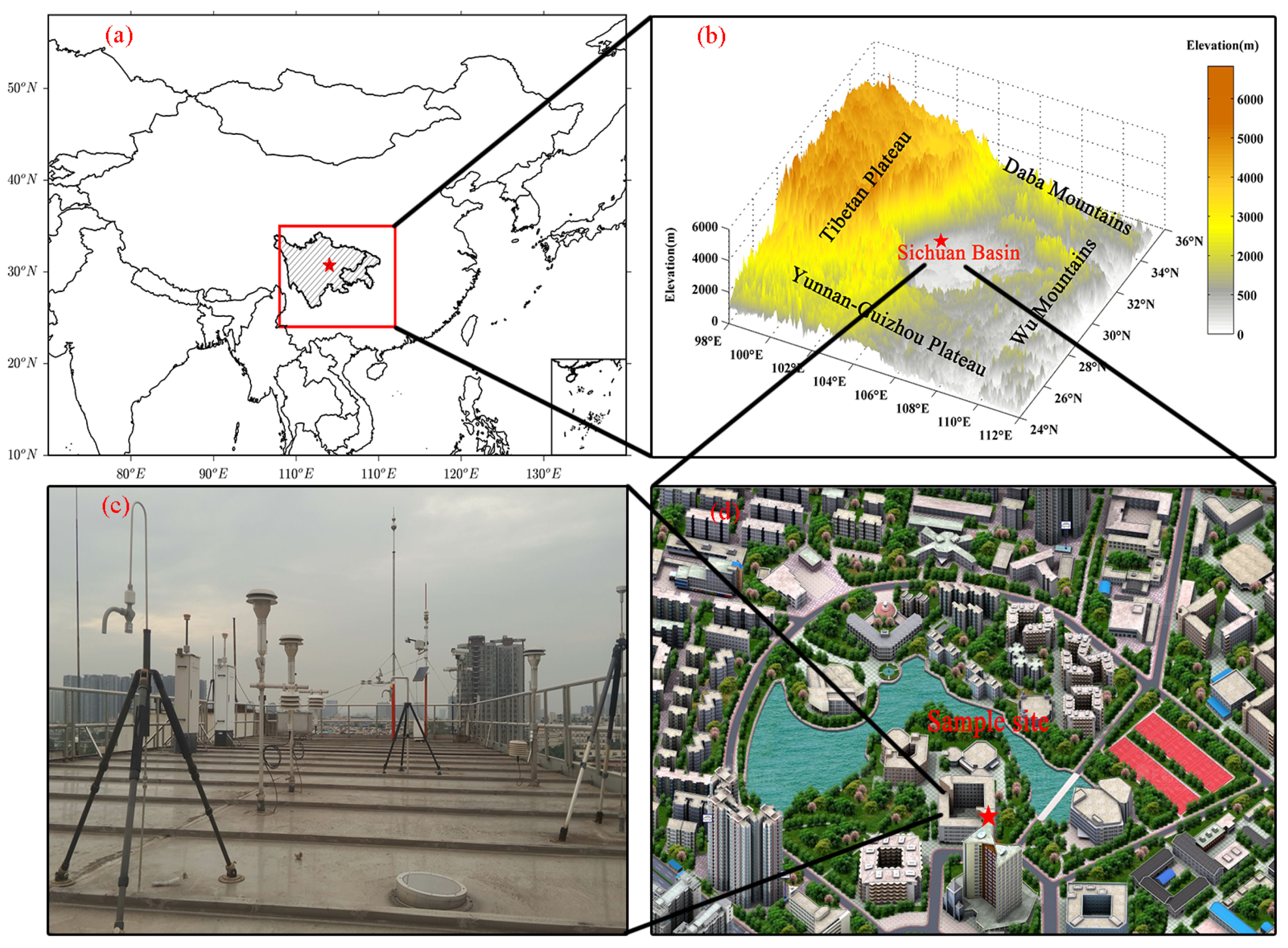
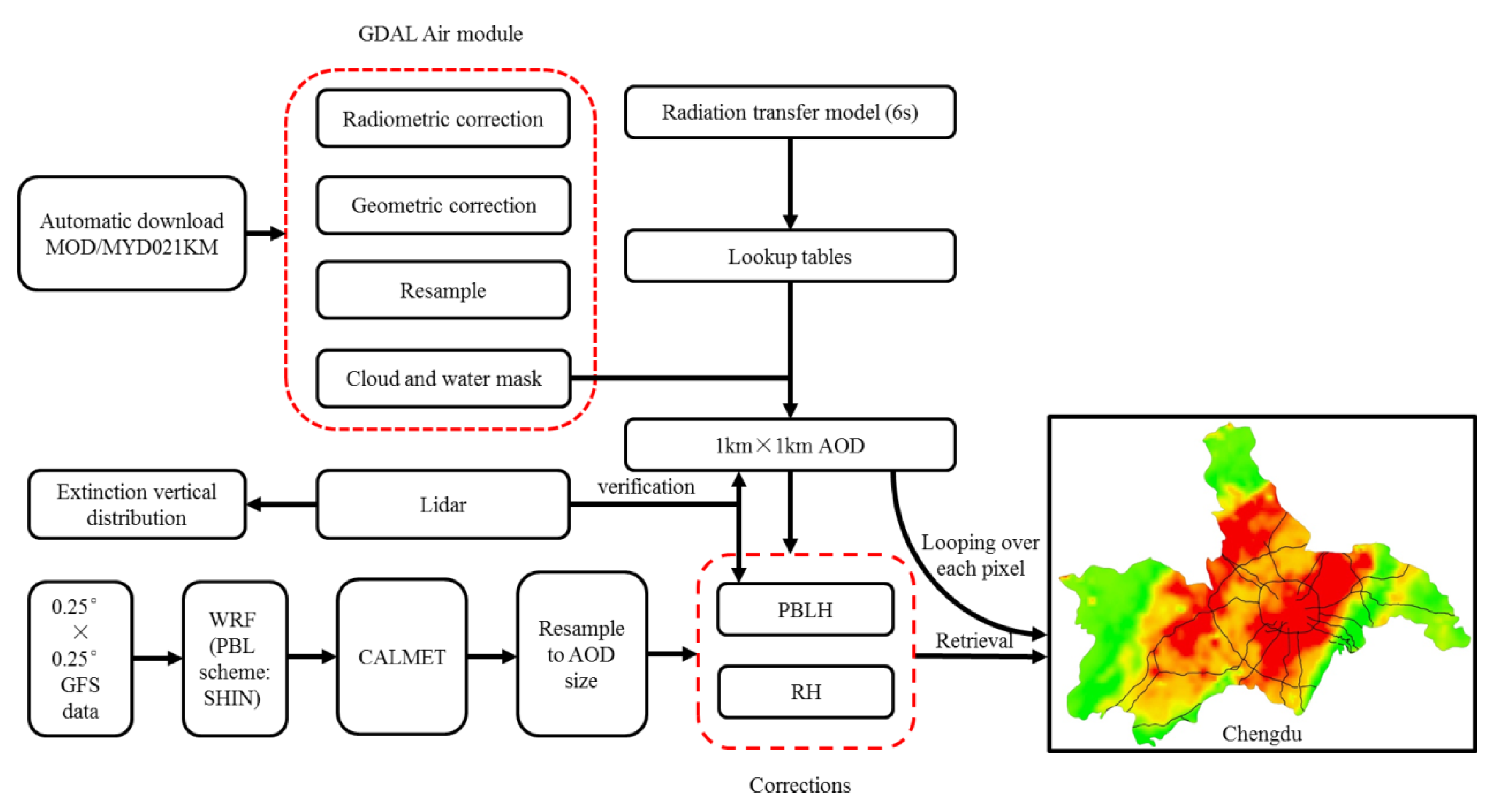

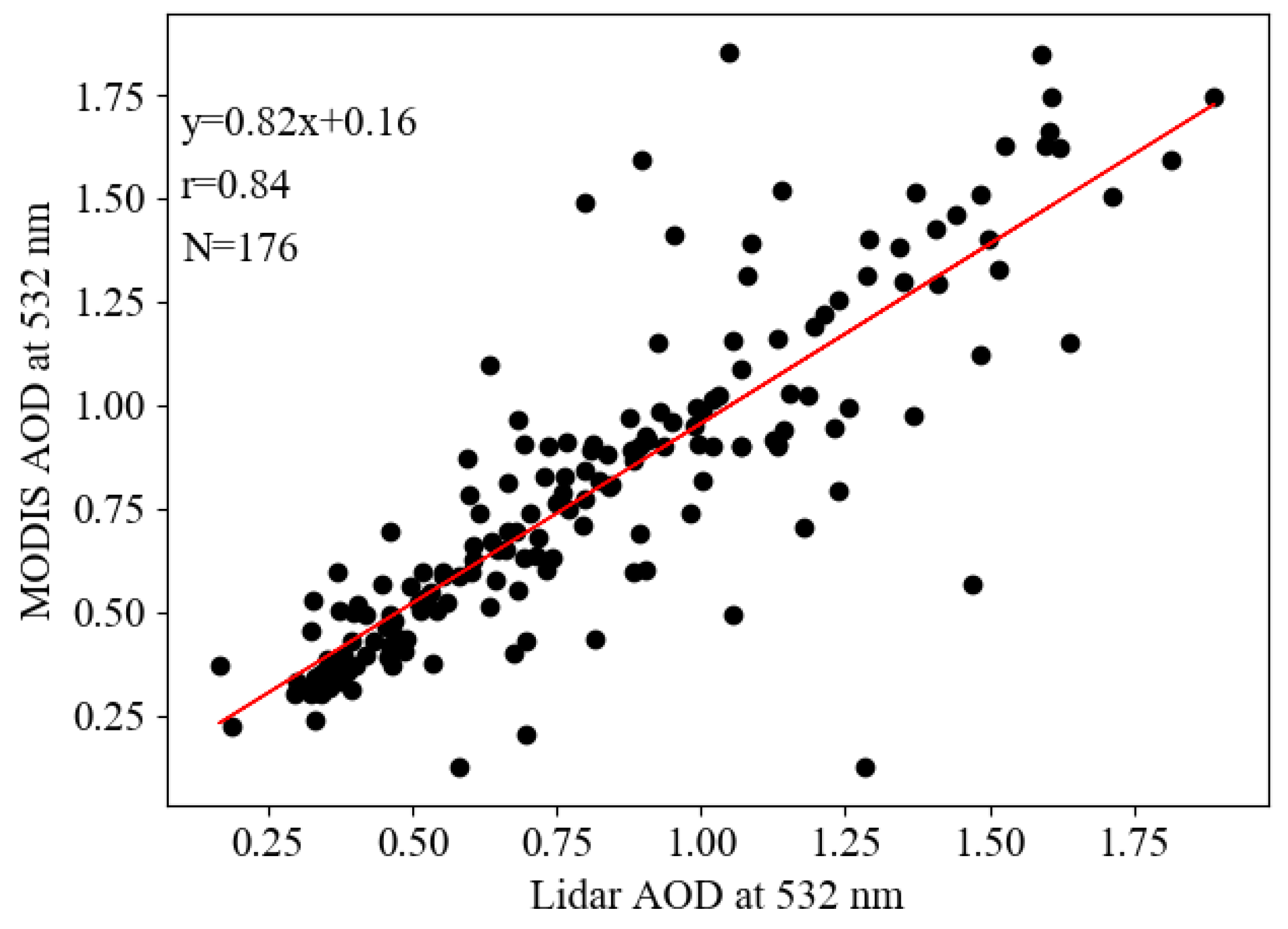
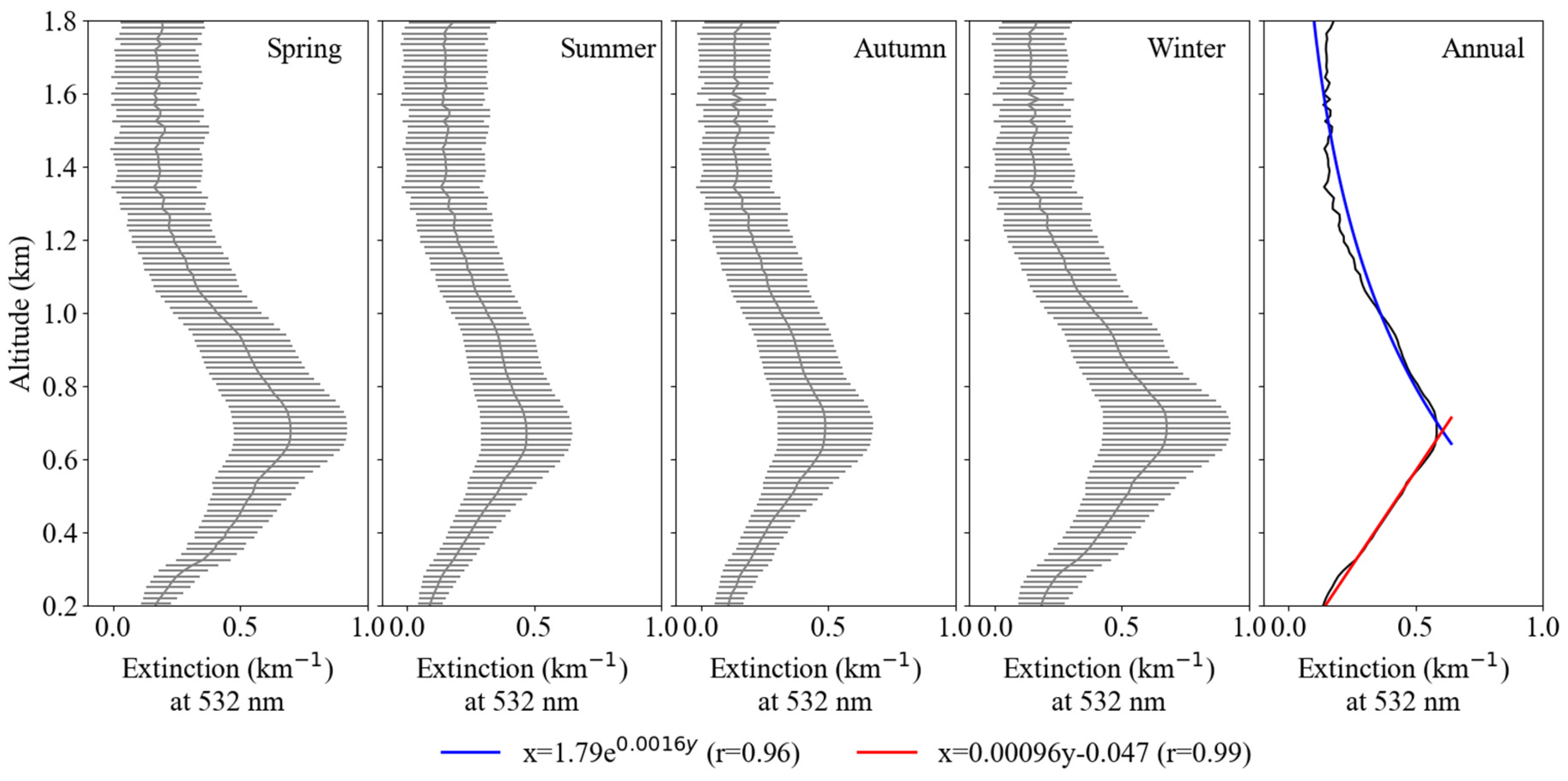
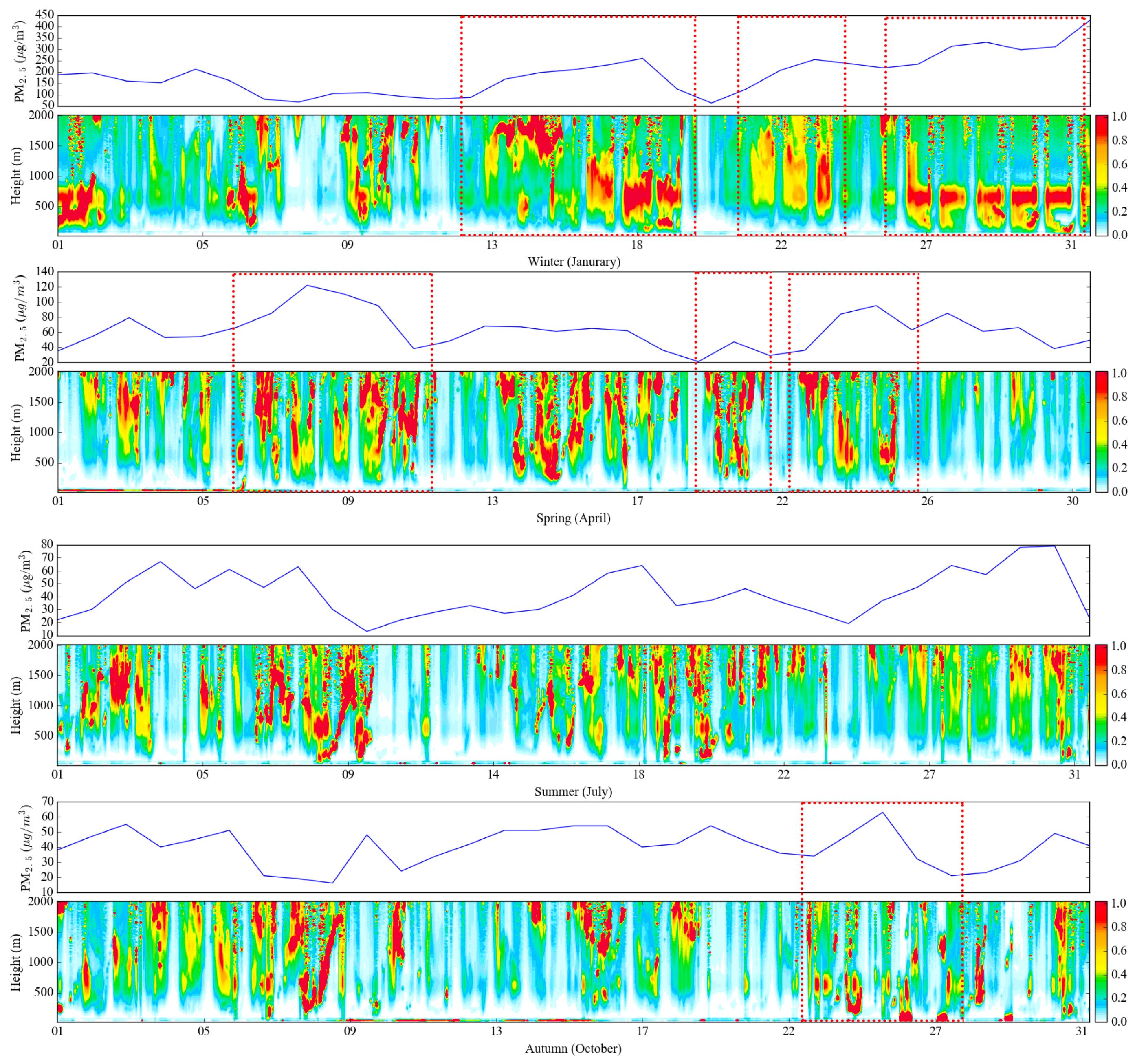

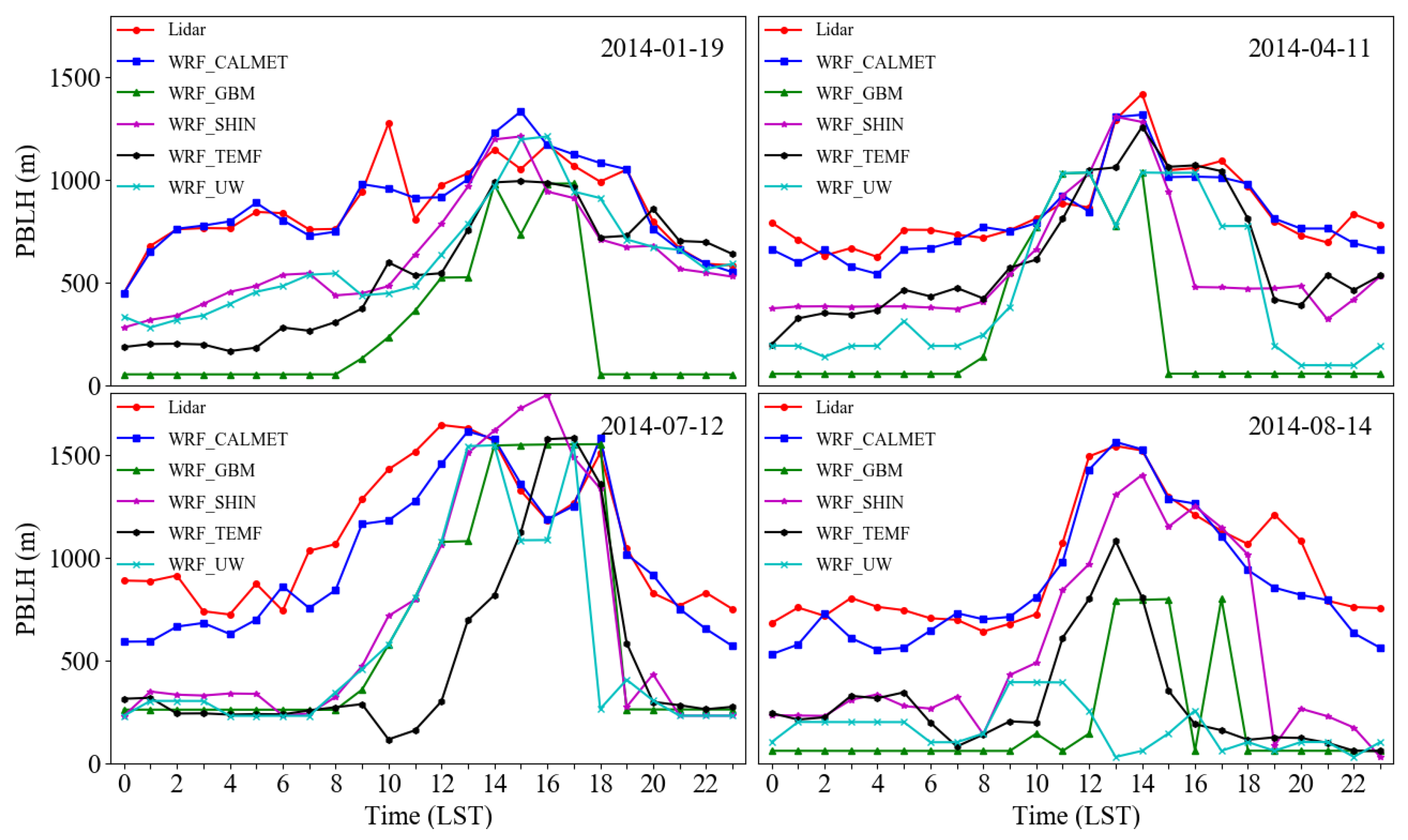
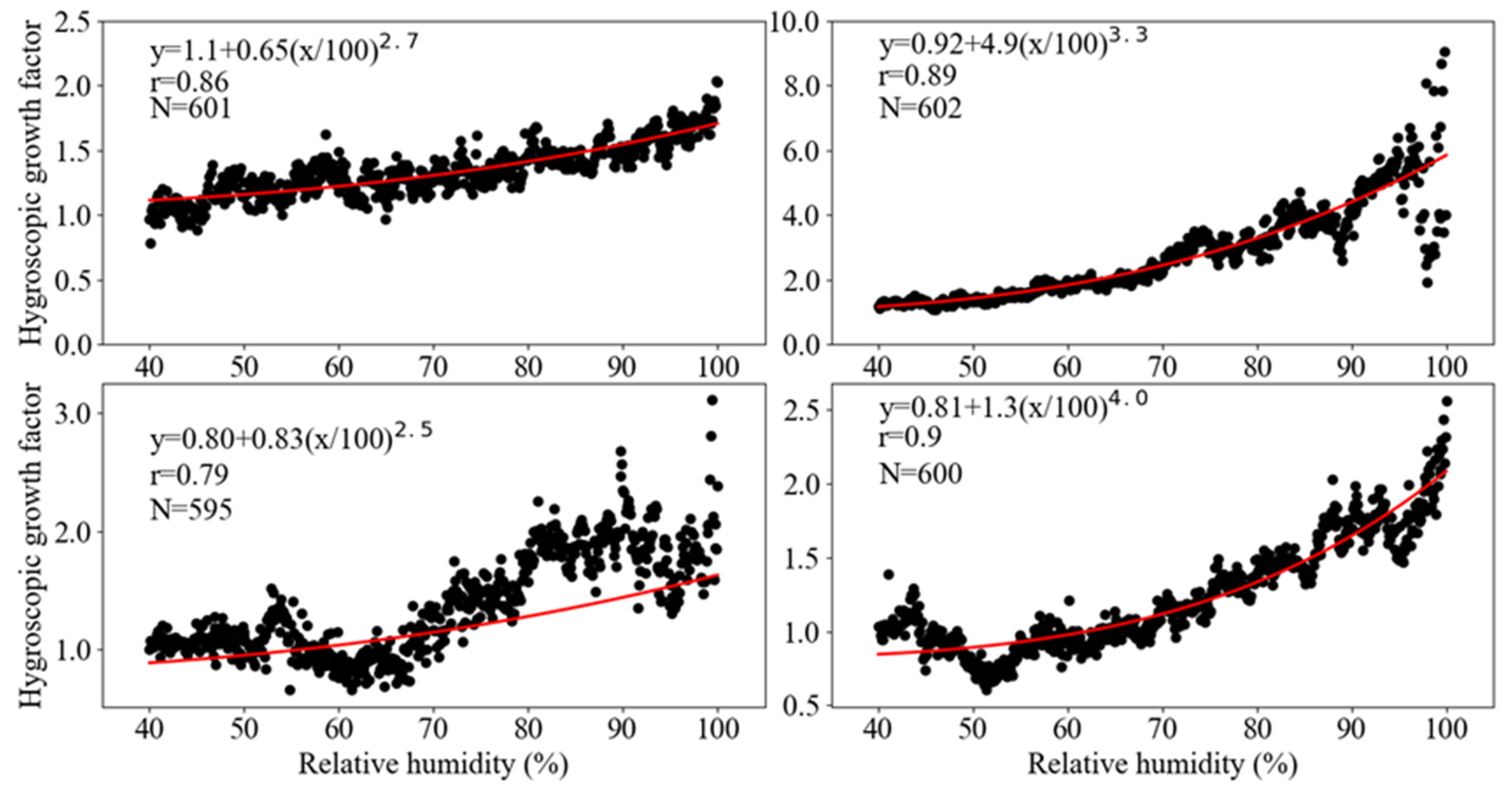

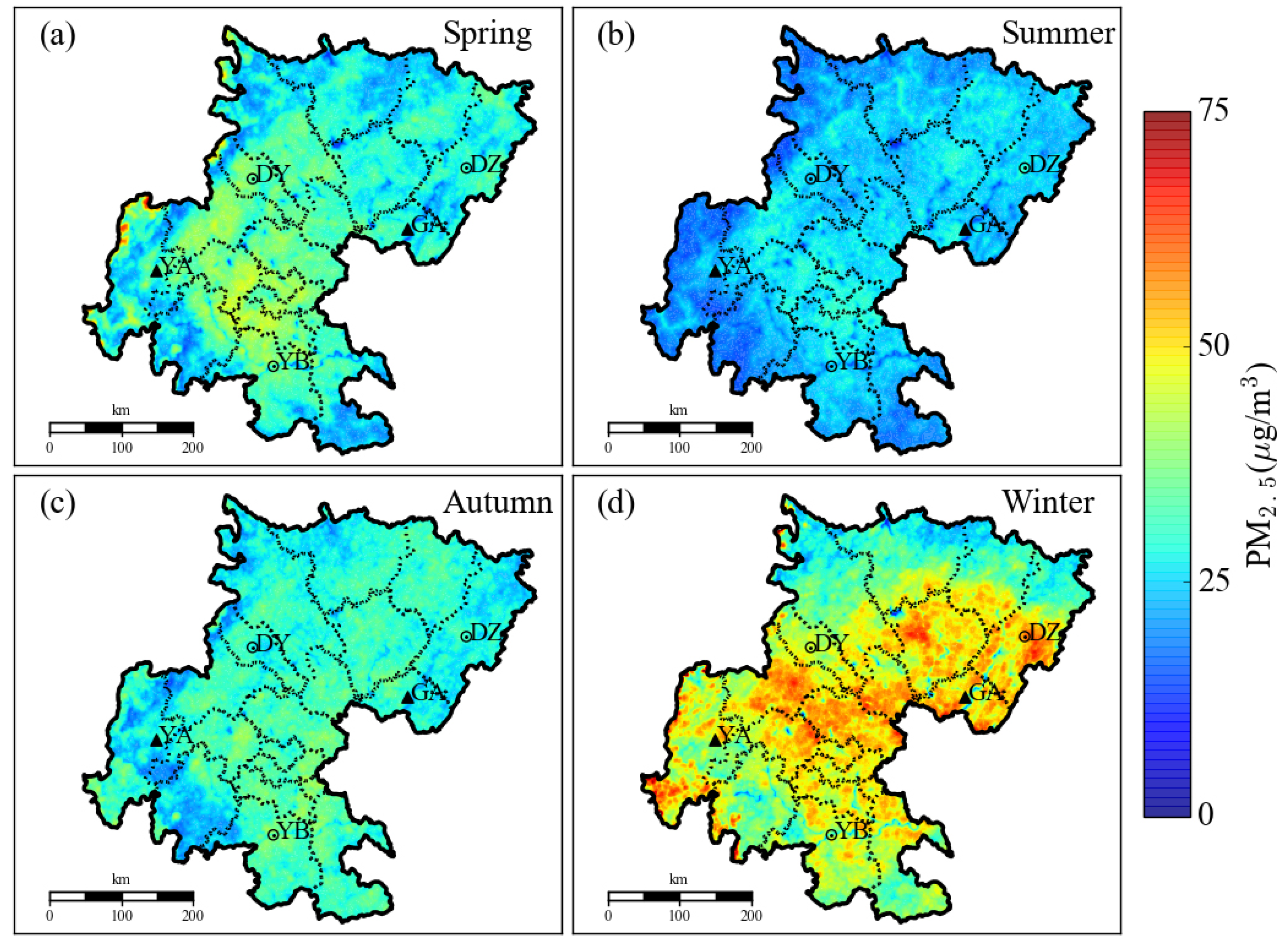
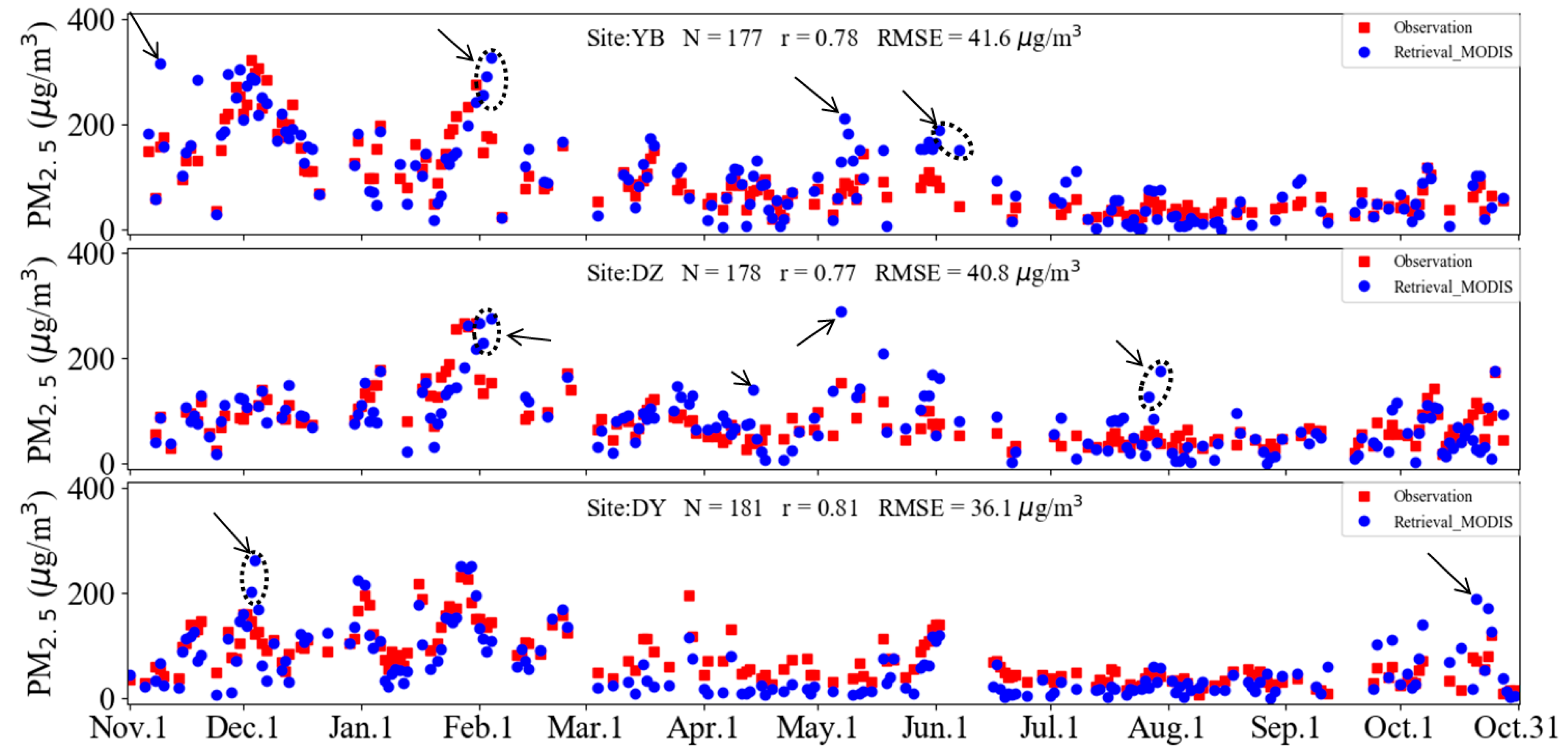
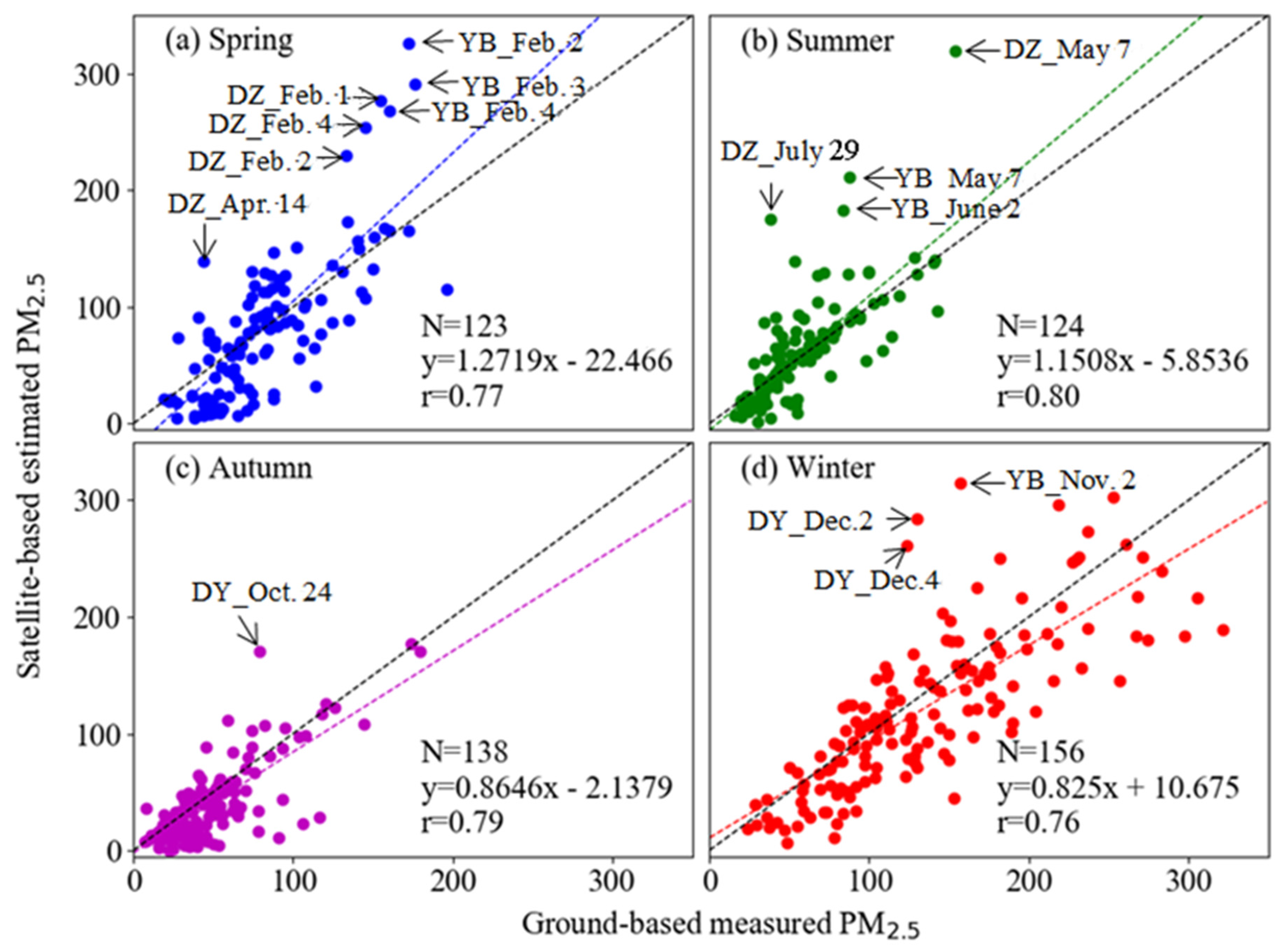
© 2018 by the authors. Licensee MDPI, Basel, Switzerland. This article is an open access article distributed under the terms and conditions of the Creative Commons Attribution (CC BY) license (http://creativecommons.org/licenses/by/4.0/).
Share and Cite
Gao, C.; Zhang, X.; Wang, W.; Xiu, A.; Tong, D.Q.; Chen, W. Spatiotemporal Distribution of Satellite-Retrieved Ground-Level PM2.5 and Near Real-Time Daily Retrieval Algorithm Development in Sichuan Basin, China. Atmosphere 2018, 9, 78. https://doi.org/10.3390/atmos9020078
Gao C, Zhang X, Wang W, Xiu A, Tong DQ, Chen W. Spatiotemporal Distribution of Satellite-Retrieved Ground-Level PM2.5 and Near Real-Time Daily Retrieval Algorithm Development in Sichuan Basin, China. Atmosphere. 2018; 9(2):78. https://doi.org/10.3390/atmos9020078
Chicago/Turabian StyleGao, Chao, Xuelei Zhang, Wenyong Wang, Aijun Xiu, Daniel Q. Tong, and Weiwei Chen. 2018. "Spatiotemporal Distribution of Satellite-Retrieved Ground-Level PM2.5 and Near Real-Time Daily Retrieval Algorithm Development in Sichuan Basin, China" Atmosphere 9, no. 2: 78. https://doi.org/10.3390/atmos9020078




